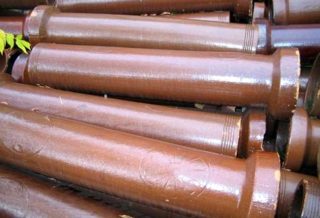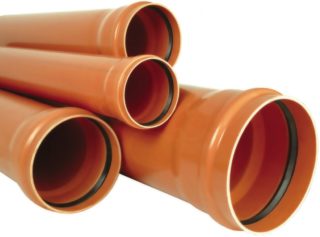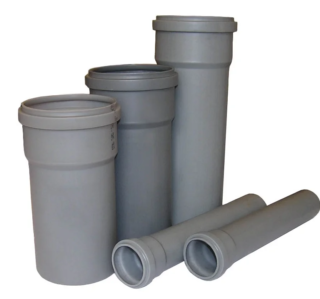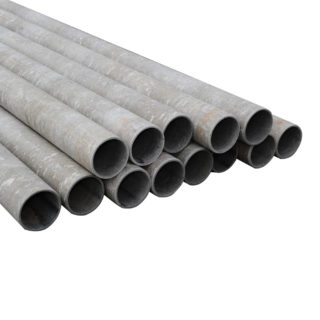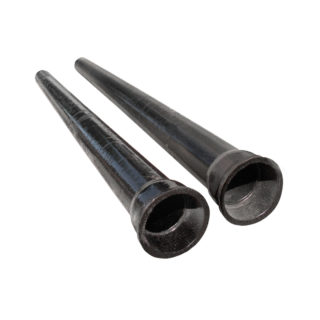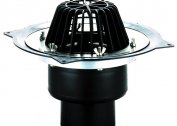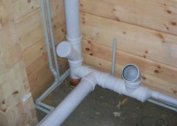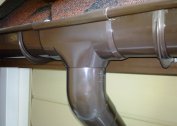The basis of the sewer system is a quality pipe. The higher the load on it, the stronger it should be. A good drainage pipe in the ground has been used for more than 25 years without the risk of clogging, breakage, depressurization of the collector. At the same time, temperature indicators do not significantly affect it.
How to choose a pipe for sewage underground
 When choosing items for outdoor sewage, it is important to consider two important parameters:
When choosing items for outdoor sewage, it is important to consider two important parameters:
- The amount of effluent that will flow through the collector. The larger it is, the larger will be the cross section of the external system.
- The level of static and dynamic load on the ground. They mean the intensity of movement in the area and the pressure of the soil on the reservoir.
It is good to use a pipe with the smoothest inner surface for sewage underground. This will prevent siltation of the system and its blockages.
Production Material and Specifications
For the production of outdoor sewage pipes, four types of materials are used - polymer, cast iron, ceramics and asbestos cement. Each of them has specific technical characteristics and is good for use in certain conditions.
Ceramics
Ceramic "sleeves" have the following positive characteristics:
- high resistance to medium and higher loads;
- high throughput with increasing diameter (up to 600 mm);
- the ability to mount on the joint / groove system without the use of additional couplings;
- inertness to aggressive wastewater.
Pipes made of ceramics have two significant drawbacks - large weight, inconvenient for self-laying of the collector, and the relative fragility of the material. With careless installation, the wall may crack. More often, such elements are used for public sewage devices.
Polymer (RFP and HDPE)
As polymeric materials use polypropylene (PPP) and low-pressure polyethylene (HDPE). In the first case, the positive characteristics of the pipes are as follows:
- high ductility, which reduces the risk of damage to the system during installation;
- good linear stretch ability;
- resistance to temperature changes;
- long service life;
- light weight of elements and ease of installation.
However, polypropylene "hoses" are unsuitable for the construction of a city collector, because according to the maximum section of the sleeve, the system is able to withstand only average volumes of effluents.
HDPE pipes differ in such characteristics:
- resistance to temperature differences in the range from -50 to +130 degrees;
- the stiffness of the elements due to the corrugated external structure (rings play the role of stiffeners);
- resistance to mechanical stress;
- tensile strength;
- smoothness of the inner walls;
- little weight;
- long term of operation.
Like PPP pipes, HDPE elements are not suitable for sewage systems with a large volume of effluents. In addition, the direct effect of ultraviolet radiation on the polymer over time destroys it. But this does not apply to external sewage.
Asbestos cement
Such a sewer pipe can be laid in the ground for any volume of effluents. It is important to choose the correct cross-section of the collector. Asbestos-cement elements are distinguished by such advantages:
- resistance to aggressive environments and to dynamic / static loads;
- inertness to aggressive components in drains;
- smoothness of the inner walls;
- less weight than cast iron or ceramic "sleeves".
In the laying of sewers, the mass of asbestos-cement pipe is often its minus, since you can not cope with such work alone. In addition, the fragility of the material under a strong point impact on it leads to a split.
Cast iron
The main positive aspects of the cast iron pipe are:
- resistance to various types of loads;
- inertness to low / high temperatures;
- corrosion resistance;
- service life (up to 80 years).
But cast iron has its drawbacks:
- tendency to siltation due to imperfectly smooth surface of the inner walls;
- weight that makes installation difficult;
- cost of items.
Cast iron pipes are strictly forbidden to be used in solonchak soils. Aggressive environments will corrode metal.
Diameter of sewer pipes
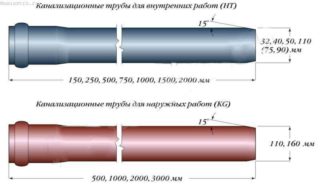 All pipes for external sewage made of various materials have a specific gradation of sizes / sections:
All pipes for external sewage made of various materials have a specific gradation of sizes / sections:
- Polymers The diameter of sewage elements is from 40 to 200 mm. As a rule, elements with a section of 40, 50 and 110 mm are used inside the house. The external collector is mounted from pipes of a larger cross section.
- Cast iron. The internal cross section (DN) starts from 150 mm and reaches a maximum value of 600 mm in increments of 50 mm.
- Asbestos cement. Such elements have a diameter of 75 mm to 600 mm.
All tubes with a diameter of 110 mm and more are intended only for the installation of external sewer networks.
Basic requirements for pipes for sewage in the ground
In order for the sewer system to work without failures, it is important that the pipes for the external collector meet the following requirements:
- Durability and long service life. For private sewage, it is from 30 years.
- Inertness to aggressive / chemical environments.
- Resistance to temperature differences.
- Maximum smoothness of the inner walls.
Provided that the system is installed correctly with a slope towards the sink receiver, the sewage system will work properly without the need for expensive repairs. At the same time, it is advisable to flush the collector under high pressure at least once every 5 years.
